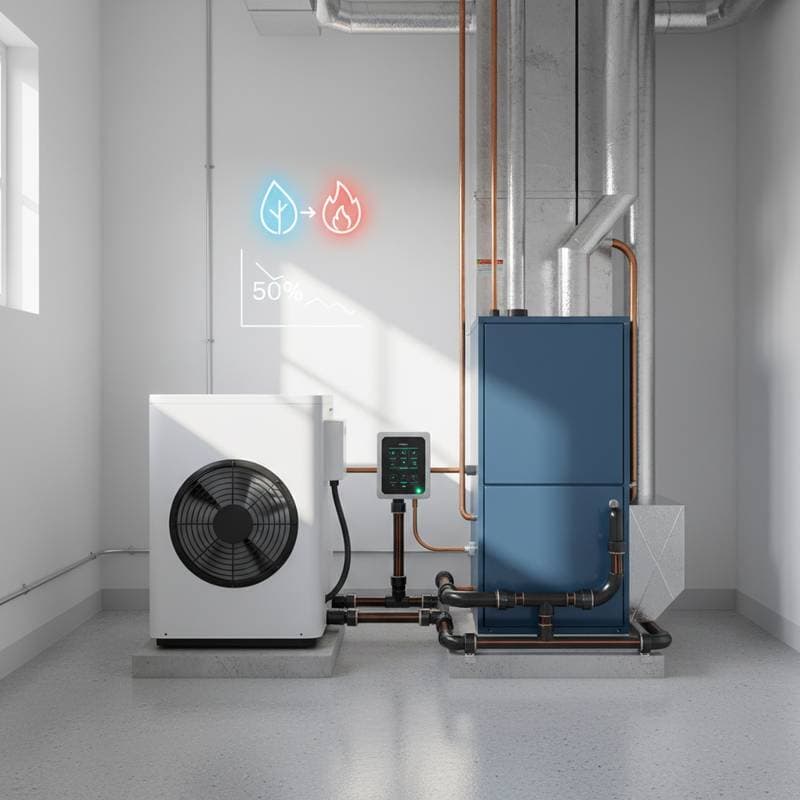Understanding Dual-Fuel Heating Systems
Dual-fuel heating systems represent a sophisticated integration of electric heat pumps and gas furnaces. These systems operate by leveraging the strengths of both technologies to maintain optimal indoor temperatures. Homeowners benefit from a balanced approach that prioritizes efficiency and reliability throughout the heating season.
Electric heat pumps excel in moderate climates by extracting warmth from outdoor air, even on cooler days. When temperatures drop significantly, the system shifts to the gas furnace for powerful, consistent heating. This automatic transition ensures comfort without unnecessary energy consumption.
How Dual-Fuel Systems Function
The core of a dual-fuel system lies in its intelligent control mechanism. Sensors monitor outdoor temperatures and system performance to determine the most efficient heating method. For instance, the heat pump handles loads above 30 degrees Fahrenheit, while the furnace activates below that threshold.
This setup optimizes energy use by matching the heating source to current conditions. Integration with smart thermostats allows for precise adjustments, further enhancing performance. Users experience seamless operation without manual intervention.
Key Advantages for Homeowners
One primary benefit involves substantial cost reductions. Dual-fuel systems typically lower heating bills by 20 to 30 percent compared to traditional single-fuel options. The heat pump's efficiency during milder weather offsets the higher operating costs of gas furnaces in extreme cold.
Environmental impact decreases as well, with reduced reliance on fossil fuels. Heat pumps produce no direct emissions, and the system's design minimizes overall energy demands. This contributes to a smaller carbon footprint for the household.
Reliability improves through redundancy. If one component faces issues, the other provides backup heating. This dual setup ensures uninterrupted comfort, even during power fluctuations or equipment maintenance.
Energy Efficiency Breakdown
- Heat pumps achieve efficiencies up to 300 percent in suitable conditions, far surpassing gas furnace ratings of 80 to 98 percent.
- Automatic switching prevents overuse of less efficient components.
- Zoning capabilities direct heat where needed, avoiding waste in unused areas.
Installation Considerations
Professional assessment determines suitability for a home. Factors include existing ductwork, insulation levels, and local climate patterns. Technicians evaluate the current HVAC infrastructure to recommend the best configuration.
Installation typically requires 1 to 3 days, depending on system complexity. Costs range from $8,000 to $15,000, influenced by home size and additional features like variable-speed components. Incentives such as tax credits can offset initial expenses.
Post-installation, regular maintenance sustains performance. Annual inspections check refrigerant levels, clean filters, and test controls. Homeowners should schedule tune-ups before winter to maximize longevity.
Comparing Dual-Fuel to Alternatives
Traditional gas furnaces provide rapid heating but consume more fuel in variable weather. Electric-only systems falter in cold climates, leading to higher bills. Dual-fuel systems outperform both by adapting dynamically.
Hybrid options like geothermal heat pumps offer similar efficiencies but at higher upfront costs. For most residences, dual-fuel strikes an ideal balance of affordability and effectiveness. Long-term savings justify the investment for many families.
Steps to Adopt Dual-Fuel Heating
Begin with a home energy audit to identify inefficiencies. Consult certified HVAC professionals for a customized proposal. Review financing options and available rebates to align with budget constraints.
Select a system with ENERGY STAR certification for verified performance. Ensure compatibility with home automation for remote monitoring. Finalize installation during off-peak seasons to minimize disruption.
Monitor usage post-installation via utility bills and smart apps. Adjust settings for peak efficiency, such as lowering temperatures when away. These practices amplify the system's benefits over time.
Realizing Long-Term Value
Investing in dual-fuel heating yields immediate and sustained rewards. Families enjoy consistent comfort alongside predictable energy expenses. The technology aligns with broader goals of sustainability and financial prudence.
As energy prices fluctuate, the adaptive nature of these systems provides stability. Home values may increase due to enhanced efficiency features. This upgrade positions households for future-proof heating solutions.



